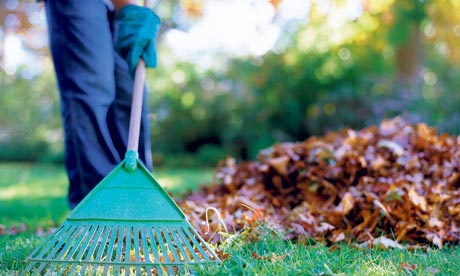How to Rake Up Leaves Safely
Winter is an etching, spring a watercolor, summer an oil painting and autumn a mosaic of them all
– Stanley Horowitz
It is that beautiful time of year again! When the trees turn colour, the air is crisp and the ground is littered with orange, yellow and red leaves. By the time the middle of fall comes around, the leaves begin to accumulate and the fallen leaves are no longer magical but become a chore. Raking is a great way to enjoy the outdoors, stay active and improve your endurance and strength. However, according to the American Academy of Orthopaedic Surgeons (Stoppler, 2010), if you are not moving properly, raking can lead to strain and injury to the back, shoulders, and wrists.
The key to a healthy garden is a healthy gardener. A common problem with gardening is that people often go into their garden and start digging or raking without giving much thought about the right and wrong way of doing it. Before you begin, warm-up with a brisk walk and rehearse the movements you will be making while you rake. This warms up the muscles you will be using so you will be less likely to injure yourself.
When RAKING and HOEING: Tools should have long enough handles to allow you to stand up straight while using them. Test out different length tools at the hardware store before purchasing one to ensure you buy one with the right length. If you use the wrong sized rake, you will end up stooping over which can cause strain on the back, neck and shoulders.
- Try your best to use your arms and avoid twisting at the trunk
When DIGGING and SHOVELLING: Depending on how many leaves are on the ground and if they are wet or dry, leaves may have to be shovelled in order to be picked up. To shovel properly, insert the head of the shovel vertically into the ground and step down on it to drive it into the matter you are picking up. It is better to shovel smaller amounts and make more trips than to lift a heavy weight. If there is a need to transport large and/or heavy loads, use a wheelbarrow or wagon for its transportation.
- Choose a shovel with a weight and handle length that is the right size for you and the job you are doing
- Spread extensive digging/shovelling tasks throughout a week rather than in a single weekend to give your body time to recover
- Take breaks throughout the activity to let your back relax
When BENDING, LIFTING and CARRYING: When lifting an object, such as a bag of leaves, bend your knees and squat down, using the powerful thigh and buttock muscles instead of your back muscles. Keep the object close to the body at all times. Whenever possible, try and use both hands to lift any objects so the load is balanced and both arms are evenly used. Whenever you need help lifting, do not hesitate to ask for it! Use a wagon or wheelbarrow to transport supplies and to carry heavy or multiple items.
- A 4 wheeled cart or wagon is sturdier and easier to use than a wheelbarrow
- Avoid reaching for objects and twisting while bending. Keep your back straight while lifting or carrying objects
ADDITIONAL TIPS
- Avoid overfilling leaf bags, especially if the leaves are wet. You should be able to carry bags comfortably, so make sure they aren’t too heavy or large.
- Wear non-slip shoes to prevent slips and falls
- As with any form of exercise, be sure to drink plenty of fluids to prevent dehydration
- Don’t overdo it. Raking is an aerobic activity – you may need to take frequent breaks or slow your pace
References
Department of Health Services, (2007). Health & Safety Guide for Gardeners. href=”http://www.cdc.gov/family/gardening”>http://www.cdc.gov/family/gardening
Hunter, L. (2009). Canadian Gardening. Stretch Before Garden Chores, http://www.canadiangardening.com/how-to/the-healthy-gardener/stretch-before-garden-chores/a/1372.
Stoppler, M. (2010). 10 Health Tips for Autumn Leaves Clean-Up. ttp://www.medicinenet.com/script/main/art.asp?articlekey=54998


